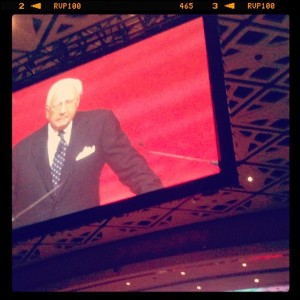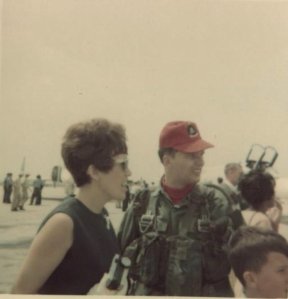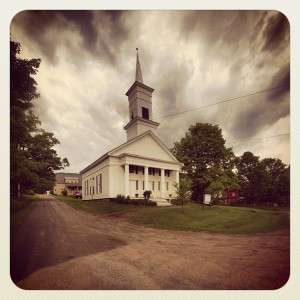I
A little over a year ago I loaded the Instagram app onto my iPhone. My first image was of David McCullough, Historian, at the 2012 AIA Convention in DC. It was an image of an image that was projected on a large screen for people like me who don’t like to sit in the front row.
His raconteur delivery and distinctive voice were wonderful, the picture is not.
It was my fourth image that made me pause and think that perhaps there was something more to this “toy” than my own narcissistic need to share my meals, my pets, my wife and kid to my Facebook Nation (FBN). It is a simple, blurry image of a young women, stylishly dressed, balanced on heals waiting for the Metro.
Despite this early triumph of transcendence I continued to stumble along with no real objective, no goal, and no other desire than to share my daily grind with my FBN. After all that’s what it’s all about—right?
Well somewhere in the midst of all this, either tangentially or parallel or whatever I began to walk to work as often as I could. I had my iPhone with me for work and I started “seeing” things and I began to photograph these things.
I think it is safe to say that nearly every person who has picked up a camera thinks to take a great photograph they must be as far away from what they know as possible. What they know is mundane and lacks interest. Exotic and unknown locales will illicit our greatest effort; the most beautiful result.
Most of these things I was seeing were surrounded by the mundane. However as I walked the same route at different times of the day and eventually in different weather the light, the atmosphere, and my mood began to pick things out of the mundane. I was swimming against the tide.
There is a misconception in photography—from the nascent to the pro—that there is little if anything to photograph in your own backyard (the mundane). When I taught photography one of the assignments I gave the students was to take pictures around their homes and yards. Other than taking portraits this was always a difficult assignment and most failed miserably.
In any case my hometown began to reveal itself. Some things were revealed immediately. Others were revealed after taking the same picture a number of times, until the time of day, light, and/or weather revealed it more completely. Others refuse to reveal themselves no matter how many times I’ve approached them.
Yet it is the mundane that can often illicit a more emotional response. Atget, Christenberry, Eggleston, Shore, Adams, Becher & Becher et. al. are examples of this. It is what we know, what we are familiar with, when we look close enough and hard enough that lets us in and reveals the wonder of the immediate.
Woodstock, Vermont, where I live and work, is a perpetual postcard. It’s one of those exotic locales that people visit to overcome what they consider their mundane existence. It’s a state of mind that allows these people to comfortably put the VT logo on their vehicles with license plates that say otherwise. It is my mundane.
The familiar often holds the most mystery.
II
On April 5, 1968 my father’s squadron flew in to Miramar Naval Air Station. He had been flying from the USS Coral Sea (CVA-43) in the Tonkin Gulf off the coast of Vietnam for close to a year-and-a-half. It was originally to be a six month tour, but the USS Pueblo was taken off the coast of North Korea and the carrier group sent to relieve the Coral Sea was diverted to North Korea. The Coral Sea remained on station.
My mother, brother, sister and I were dressed in our finest on a typically sunny and warm California day. As we watched one and then another and finally the rest of the squadron touched down. With their canopies raised they taxied to an area of the tarmac where the squadron families waited. One by one the large and noisy F-4Bs shut down their engines as the ground crews chocked the tires and the flight crews safed various systems. VF-151 had returned minus a few aircraft and crew that had been shot down during their tour. The Coral Sea would steam into San Diego harbor minus the aircraft.
I was nine, my brother seven and my sister four. For my sister this man was a stranger. For my brother and I he was not that much more familiar. As a carrier pilot in the Navy, this was the way it was—nothing out of the ordinary.
If not for a collection of blurry Kodak Instamatic photographs this event would be part of my families’ oral tradition. These square images with dubious color value fill in a lot of blanks and inspire further memory. I’m not even sure where some of the pictures came from as my mother, Instamatic in hand, is in a number of the pictures. Who took them?
Memories are like clouds–seemingly substantial in the middle and a bit fuzzy around the edges. That substantial core dissipates with time and if not for, often blurry, pictures taken by, sometimes, unknown actors they can disappear completely.
III
In a very roundabout way I came upon the Instagram.
I initially boycotted it for no other reason than I didn’t think it would do what I wanted it to do and I didn’t know what I wanted to do, Instagram or not. What I did like once I began to use it on my iPhone were the borders and the treatment that came with each border. What I didn’t like was that I was tethered to my low resolution iPhone.
Another, seemingly, unrelated event was the purchase of an iPad. I bought it to allow me to work while at the AIA Convention. Initially I didn’t load the Instagram app because it is a first gen model with no camera. What I didn’t know was that Instagram works with any image loaded on the device.
When, how or why I figured out that I could use my “good” camera to take the pictures, upload them to the iPad and then run them through Instagram I don’t know.
It was by trial and error and total happenstance that I found that I could use my DSLR, upload those images to my iPad and then run those through Instagram. I quickly appreciated the feel of the Instagram and just as quickly adopted the Earlybird border for my images.
Why Earlybird? It’s the way I see. It’s how my memories are framed in my mind. Those blurry, low resolution photographs illustrate a moment long gone and not well remembered. The square format, sometimes scalloped edges and dates burnt in the margin are historic family documents. These are the filters that blur and define my past. It was with that in mind that I set out to find a way to recreate that feeling with digital images.
IV
I can’t say why photography initially intrigued me, but I do remember the first time I saw an image reveal itself in the developing tray. Way magic.
However, beyond that first bit of magic, I wasn’t overwhelmed by the need to create the perfect print. The less time spent in the darkroom the better for me. I did like to kibitz in other people’s darkrooms, but that was social and didn’t involve big decisions about burning, dodging, split toning or poisoning myself with selenium.
Having said that I wasn’t particularly intrigued by the immediacy of the Polaroid either. I did have a Polaroid back for my 4×5 and I messed with it a bit, but never too much affect.
So that brings me back around to a nagging question—why Instagram?
Well….
I keep wanting to go off on an art historical tangent, but I’ll keep this to me.
First, I am a photographer. There I said it, now I can begin my twelve step program. Anyone who saw my thesis show, years ago now, at Virginia Commonwealth University would be suspect of this statement (https://www.facebook.com/photo.php?v=1794836319529&set=vb.1498341035&type=3&theater). And I, for quite some time, was just as suspect.
I have always had issue with the un-manipulated image for my own form of expression—whatever that may be. My constructions had bits of photography that were most often secondary, even tertiary, elements of the larger work.
Fast forward to today and I’m not as adverse to leaving the image alone. But, let’s be honest, even the most un-tickled image has been manipulated in some manner or other. Ansel Adam’s “Moonrise, Hernandez, New Mexico” is spectacular in its purity. I could spend hours (and have) getting lost in that picture. But from Adam’s initial exposure selection to an orchestration of burning and dodging, pushing and pulling to fit properly within his Zone System there has been quite an effort to reach that purity.
Now, before you jump on me and my lack of hubris, I am not saying that any of my images are on the level of Ansel Adam’s work, simply that my images are just as manipulated.
As I take my long walks built on short steps I am looking at my world through an Instagram filter. However, as I mentioned earlier, it is a filter I had used long before stumbling across the Earlybird border. The border in combination with the very wide angle lens I use is “how” I see.
Secondly, I have an outlet.
Incalculable numbers of images are taken every day, month and year. The fraction that are actually seen by others is miniscule. Those of any visual “value” even further towards the fractional. Again, before you jump all over me, I am not saying that any more of mine are of visual “value” than anyone else’s. I, like many others, am using my FBN as a rotating gallery.
Finally, I am setting my images free.
And with Instagram I have set myself free. I am no longer tethered to the hesitancy of film, long hours in the dark room and wondering whom, if anyone, would ever see the images I took. I now let my images percolate through the mundane that is my existence and share them for good, bad, or indifferent with my FBN.
Welcome to my world.



